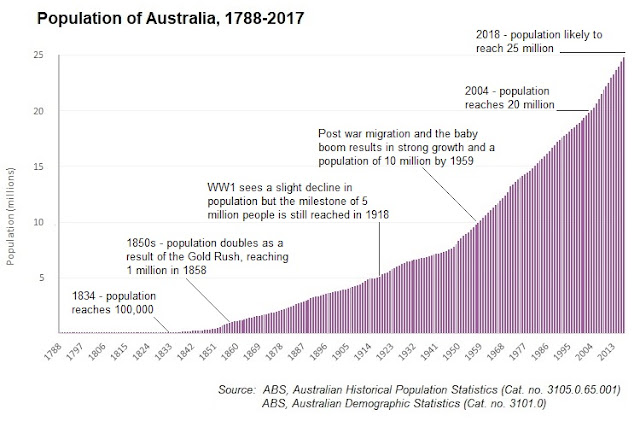Happy World Population Day! On this day when we focus on all things population, why not have a look at the history of Australia's population since 1788. There's no doubt that Australia is recording strong population growth in the current era, and the ABS estimates that Australia reach a population of 25 million in the coming weeks. But how did we get here, and when did we reach other population milestones in the past?
What is Australia's population?
The ABS recently released population data for the year ended December 2017 indicating a population of 24.77 million. I summarised the key points in this blog. While these are the official statistics, the ABS also maintains a population clock on its website. This provides an estimate of the population based on assumptions for births, deaths and migration. At noon AEST on the 11th July 2018 the population clock indicated the population of Australia was 24,971,251 - very close to the 25 million milestone.
Where does Australia sit globally?
On a global scale, Australia's population of almost 25 million ranks 53rd of all countries. The largest countries by population are China and India with populations of 1.39bn and 1.33bn respectively. There are 13 countries with more than 100 million people.
United Nations data indicates that over the period 2010-15, Australia's population growth rate was 1.5%, compared to a global average of 1.2%. It was also higher than the global average in 2005-2010 whereas in the previous three or so decades it was consistently below.
Australia's historical population growth
The graph below shows the population of Australia from 1788-2017. From the beginnings of a small colony of less than 1,000 people, it took more than half a century to reach a population of 1 million. This occurred in 1858 - a decade of very strong population growth on account of the Gold Rush. In fact, Australia's population doubled between 1852 and 1858 which really shows the impact of the wave of migration that occurred at the time.
At the time of Federation on 1st Jan 1901, Australia's population was 3.77 million. Despite a slight decline in population during WW1, the population reached 5 million in 1918 as soldiers returned from the battlefields. It took another 40 or so years to reach 10 million people (1959) and slightly longer to double again, with the population reaching 20 million in 2004. 14 years later, with a short lived mining boom and a period of strong global migration we are about to hit 25 million people.
In this current era of strong population growth there are calls to cut growth (primarily through the migration program), but a glance at Australia's population history shows that the rate and volume of growth varies considerably. Much of this is linked to economic conditions. It might surprise some people that Australia's population grew by more than 1 million during the boom economic times of the 1880s, with an annual average growth rate of 3.5%. The first time the annual population increase was more than 100,000 was in 1883. However during the 1890s, when the economy was largely in recession the volume of growth was around 653,000 for the decade with an annual average growth rate of just under 2.0%. Growth was even slower in the first decade of the twentieth century.
While I don't wish for an economic recession to reduce population growth, the point is that history shows that population growth responds to all sorts of stimuli. Migration in particular is a very volatile component of population change. There are many examples of the ebbs and flows of population change since 1788. A more recent example is the slower growth during the 1990s recession, only to increase again in the late 2000s. And you only have to read my blog on Western Australia to show the impact of the recent mining boom (during and post) on population growth.
Summary
Australia's population at December 2017 was 24.77 million and will likely reach 25 million before the end of 2018. Since 1788 Australia's population growth has varied but is generally linked to economic conditions, with stronger growth rates recorded during times of economic prosperity. In 2010-2015, Australia's growth rate was higher than the global average.
In 1834 Australia's population reached 100,000 and had reached 500,000 by 1852. Six years later it reached 1 million - the strong growth a reflection of the strong migration that occurred during the Gold Rush. By 1918 the population was 5 million, by 1959 it was 10 million, and the 20 million mark was reached in 2004.


No comments:
Post a Comment